Shrines in Nara associated with Oda Nobunaga are scattered throughout the region, yet each one is small in scale, understated, and far from being major tourist spots. Because of this, it’s difficult to grasp their true character through written sources alone. That’s exactly why this site uses 360-degree panoramic photography—allowing you to experience the atmosphere of each shrine, the feel of the grounds, and the surrounding everyday scenery as if you were physically standing there.
But the deeper value of this site lies in the fact that these three shrines together reveal “strategic patterns of faith”—how later generations remembered and made use of Nobunaga.
- Shinran Daimyōjin (Kashihara City): A local mystery where only the “name” remains. With no solid historical records to explain it, the survival of Nobunaga’s name within an Inari shrine symbolizes gaps in the historical record and the shifting nature of religious belief.
- Takeisao Shrine (Sakurai City – Shiba): A strange scene where the memory of a great historical figure fades into everyday life. A seesaw sits at the feet of a statue of Nobunaga, creating a surreal blend of the ordinary and the extraordinary, where the ruler of the realm coexists with a local playground.
- Takeisao Shrine (Tenri City – Yanagimoto): A place that reveals layers of history, where the authority of the ancient world overlaps with that of the samurai class. Backed by a massive kofun-era burial mound, the Oda clan—lords of the early modern period—enshrined Nobunaga here as a strategic statement of legitimate rule.
More than any written history, these three locations are defined by an atmosphere you can only grasp by being there. Thanks to the 360-degree panoramas, you can feel the quiet of the grounds, sense the rhythms of daily life, and experience the layered presence of different historical eras—almost as if you were visiting in person.
These shrines may not be places where Nobunaga himself once stood. Even so, they vividly show how later generations chose to enshrine him, remember him, and weave his memory into their everyday world. The greatest value of this site is the ability to relive that “story found in the margins of history” through immersive panoramic imagery.
As you walk the streets of Nara and explore the 360-degree views on this site, we invite you on a quiet, thoughtful journey—one that encourages you to overlay your own image of Nobunaga with the living memory of Nobunaga preserved in these communities.
Nobunaga Daimyōjin (Shinguchi-chō, Kashihara City)
⭐ Recommended Rating
Historical Value: ☆
Uniqueness of Local Faith: ☆☆☆
Mystery Factor: ☆☆☆

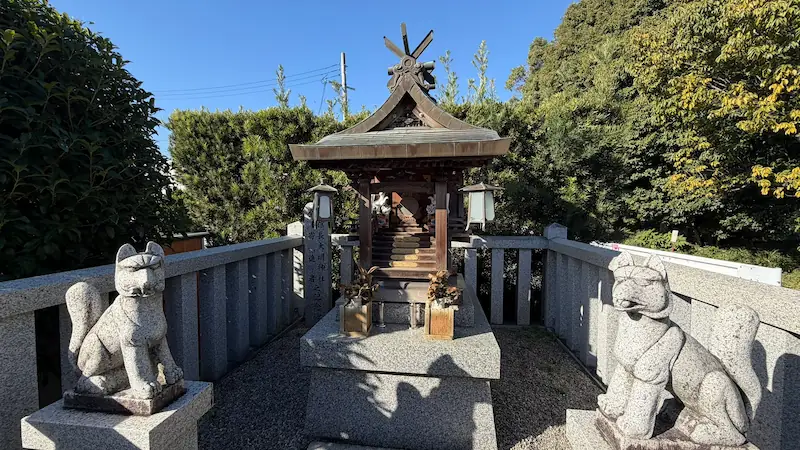
Overview
Tucked quietly within a residential neighborhood in Shinguchi-chō, Kashihara City, “Nobunaga Daimyōjin” (a commonly used name rather than an official one) is a tiny shrine known only to those who seek out the deeper layers of local history. With virtually no formal records documenting its origins and completely untouched by tourism, it stands as a micro–local heritage site. The shrine is located at address “488-4,” and together with the adjacent Suga Shrine, it forms the spiritual core of the Shinguchi-chō community.
The shrine’s highly unusual name—“Nobunaga Daimyōjin”—naturally evokes an association with Oda Nobunaga, the famed warlord of the Sengoku era. However, no conclusive historical sources confirm any direct connection. The structure itself resembles an Inari-style shrine, marked by a series of bright vermilion torii gates. This makes the question all the more intriguing: why and how did the name “Nobunaga” become attached to a local Inari deity in the course of the community’s religious history? The shrine stands today as a living reminder of that unresolved mystery.
The grounds are extremely small, with no elaborate decorations or large structures. Yet this modest scale is precisely what conveys its role as a deeply rooted “ujigami”—a neighborhood guardian deity intimately woven into everyday life in Shinguchi-chō.
When you visit, be sure to explore it together with the neighboring Suga Shrine. Immersing yourself in the calm, everyday scenery shared by these two shrines will help you sense the quiet spiritual rhythms of Shinguchi-chō. Located just a short walk from Shin-Nokuchi Station on the Kintetsu Kashihara Line, the site is an ideal stop during a stroll through the historic Yamato region—perfect for letting your imagination fill the gaps left by the historical record.

■ Panoramic Photo
| Construction Date / Builder | Unknown (maintained through long-standing local faith) |
|---|---|
| Structure & Features | A small Inari-style shrine with vermilion torii gates and a stone marker; positioned directly along a local residential road. |
| Renovation / Restoration History | No recorded information (details unknown) |
| Current Condition | Standing; open to visitors in Shinguchi-chō, Kashihara City. |
| Damage or Loss | No known incidents |
| Cultural Property Status | Not confirmed |
| Notes | The shrine’s very name, “Nobunaga Daimyōjin,” is the greatest mystery. No confirmed connection to Oda Nobunaga has been established, and the site remains a topic of debate among local historians. |
🗺 Address: 奈良県橿原市新口町488-4
🚶 Access:
Nearest station: Shin-Nokuchi Station (Kintetsu Kashihara Line), approx. 5 minutes on foot (about 0.3 km)
⏳ Estimated Time for Your Visit
Time to appreciate its uniqueness: approx. 10 minutes
If you also explore the surrounding streets and Suga Shrine: approx. 20 minutes
📍 Highlights
- The enigmatic stone marker and name plaque: The stone marker carved with “Nobunaga Daimyōjin” defines the very identity of this shrine. Why has the name of Nobunaga—who is believed to have had little direct connection to this area—been preserved here? Standing before this marker is one of the most fascinating moments of the visit, inviting you to consider the mysteries of local religious tradition.
- A humble, everyday Inari-style presence: Instead of a large worship hall or impressive gate, the short, natural approach leading through vermilion torii to the main sanctuary reveals the shrine’s character as a “deity of everyday life,” rather than a monumental sacred site.
- Contrast with Suga Shrine: Visiting together with the neighboring Suga Shrine—dedicated to Gozu Tennō—highlights the unique role and peculiarity of this tiny shrine. The close coexistence of two shrines venerating different deities captures the historical depth of Shinguchi-chō.
📌 Trivia (for the curious visitor)
- The debate over the shrine’s name: Despite its name, no clear historical evidence links the shrine directly to Oda Nobunaga. A prevailing local theory suggests that the original name of the Inari deity may have shifted phonetically over time, eventually becoming “Nobunaga” by coincidence. The very presence of this historical “blank space” is what makes the shrine so compelling.
- Best approach route: Located just south of Suga Shrine and with no confirmed parking, the most immersive way to visit is to walk from Shin-Nokuchi Station, strolling through the streets of Shinguchi-chō to experience the surrounding atmosphere.
- The Nobunaga–Yamato connection: Many regional guides and historians point out that Nobunaga had relatively limited direct involvement with Yamato Province (modern Nara Prefecture). As a result, the shrine is best appreciated not as a conventional “hero shrine,” but as a local mystery rooted in community memory.
Kenkun Shrine (Shiba, Sakurai City)
⭐ Recommended Rating
Historical Value: ☆☆
Sense of Otherness: ☆☆☆
Degree of Clash with Everyday Life: ☆☆☆
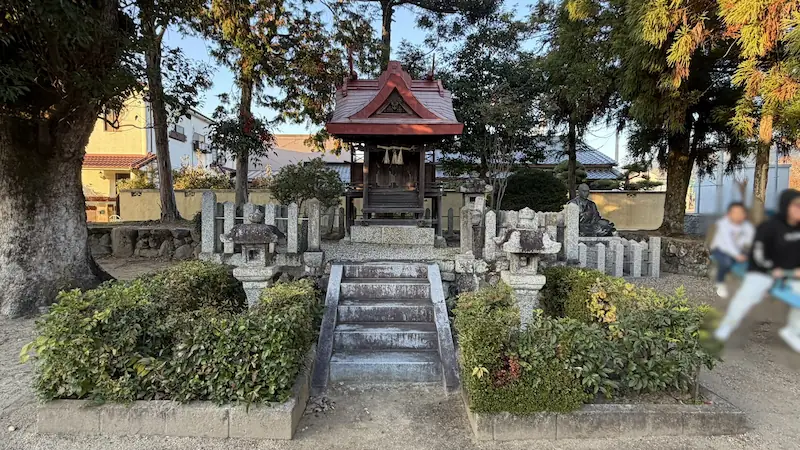
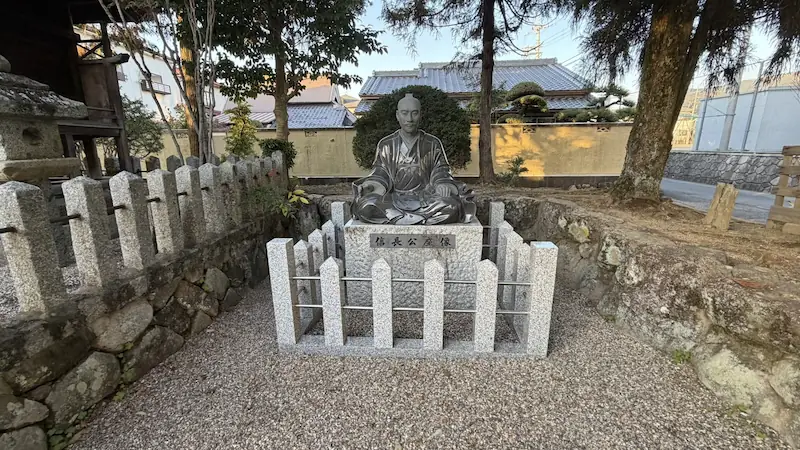
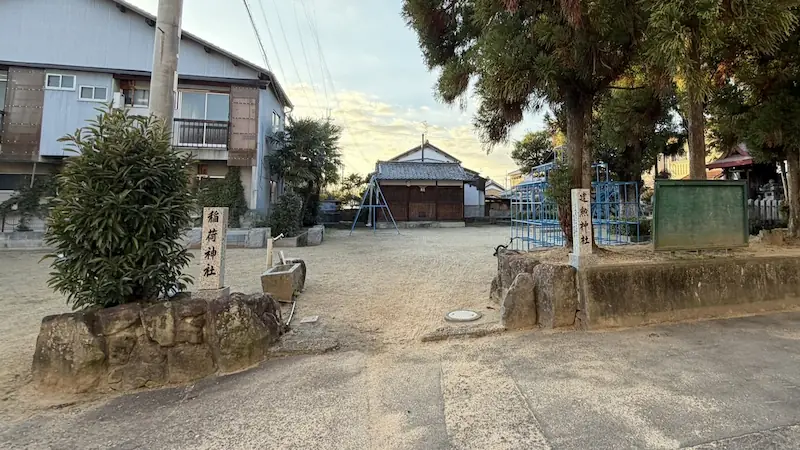


Overview
Located in Shiba, Sakurai City, Nara Prefecture (the former village of Shiba), Kenkun Shrine enshrines the Sengoku warlord Oda Nobunaga as its deity and is affectionately known by locals as “Shinchoko-san” (a nickname for Lord Nobunaga). The greatest appeal of this place lies in how the overwhelming historical presence of a “unifier of the realm” sits side by side with the everyday routines of the neighborhood. On the adjacent land once stood the domain’s former jin’ya (administrative headquarters), now the site of Oda Elementary School. The school crest incorporates the Oda family crest, a clear reminder that this area was once part of the Oda clan’s domain.
Within the shrine grounds you’ll find a seated statue of Nobunaga, but at his feet is a space that functions as part of a children’s playground. This bizarre yet charming scene—a seesaw set right in front of Nobunaga’s statue—is vivid proof that this shrine, as a “fragment of history,” has taken root in a unique way in the everyday lives of local residents.
Believed to be a branch shrine of the main Kenkun Shrine in Kyoto, this compact neighborhood shrine is an easy place to drop by, yet the more you learn about it, the more clearly you feel the unusual bonds between the Oda clan’s history and the local community. It’s a micro-destination well worth visiting with a bit of strategic planning for anyone tracing Nobunaga-related sites in Nara.
■ Panoramic Photo
| Foundation / Relocation | Believed to have been relocated and developed by at least the Meiji era (within the former village of Shiba). |
|---|---|
| Founder | Thought to have been established and enshrined by local residents with ties to the former Oda domain; no detailed records of specific founders survive. |
| Structure & Features | A small shrine precinct adjoining an Inari shrine, featuring a seated statue of Oda Nobunaga and playground equipment. |
| Renovation / Restoration History | The grounds were relocated and improved over time; some sources suggest relocation around 1896 (Meiji 29). |
| Current Condition | Still standing and open to worship. Located around the Tama-zuka area of Shiba, Sakurai City. |
| Damage or Loss | No notable incidents reported. |
| Cultural Property Status | None confirmed (considered a local community shrine). |
| Notes | The name “Kenkun Shrine” indicates that it is regarded as a branch of the main Kenkun Shrine in Kyoto’s Kita Ward. |
🗺 Address: 奈良県桜井市芝 字玉塚 他
🚶 Access:
Nearest station: around 20 minutes on foot from Miwa Station
⏳ Suggested Time on Site
Quick highlights (Nobunaga statue and playground): approx. 10 minutes
For a deeper visit (former jin’ya site and neighborhood stroll): approx. 20 minutes
📍 Highlights
- The surreal pairing of Nobunaga’s statue and a seesaw (top highlight): In front of the seated statue of Lord Oda Nobunaga, you’ll find a seesaw and other playground equipment that local children actually use. This overwhelmingly unique sight—where a once all-powerful warlord shares space with a neighborhood play area—is the shrine’s most striking visual feature, and something you’re unlikely to encounter anywhere else.
- Traces of the old jin’ya at Oda Elementary School: The adjacent Oda Elementary School stands on the former site of the Shiba domain’s jin’ya. Look closely at the school gate and crest to see the Oda clan’s family crest (Oda mokkō). Spotting it for yourself is a concrete way to feel the enduring historical connection between the Oda family and the local area.
- The atmosphere of “Shinchoko-san,” a beloved local deity: Though the shrine is not grand, the quiet grounds blend seamlessly into the surrounding residential streets. Here you can sense how “Lord Nobunaga” continues to be revered and affectionately known as “Shinchoko-san,” both respected and familiar as a local protective presence.
📌 Trivia (for curious explorers)
- The meaning of the divine title “Kenkun”: “Kenkun” is the divine name granted to Oda Nobunaga by Emperor Meiji in recognition of his great achievements in moving Japan toward unification and restoring imperial court ceremonies. The fact that Nobunaga is enshrined here reflects not only local ties but also a broader history of his veneration that took shape from the Meiji period onward.
- Local connections: Nobunaga is enshrined as the main deity, and historians have pointed out links to descendants of the Oda clan and to the former domain itself. In this sense, the shrine represents a form of worship and commemoration consciously chosen by the local community.
- Access and strolling: As there is no dedicated parking, the best strategy is to visit by public transportation (via the Sakurai area) and plan your trip as a walking tour. That way, you can enjoy both the residential scenery and the scattered fragments of local history that surround this unique shrine.
Kenkun Shrine (Yanagimotochō, Tenri City)
⭐ Recommended Rating
Historical Value: ☆☆
Depth of Overlapping Historical Layers: ☆☆☆
Contrast with Ancient Belief Systems: ☆☆☆


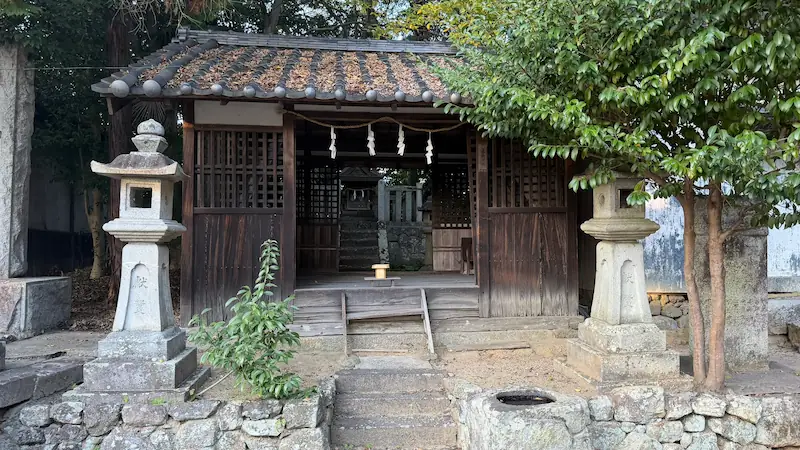
Overview
Kenkun Shrine, located in Yanagimotochō, Tenri City, Nara Prefecture, is a subsidiary shrine (massha) within the grounds of Isanagi Shrine, a major sacred site whose origins date back to the Kofun period. Here, you can literally see layers of history stacked on top of one another: the immense authority of ancient burial mounds (the Yanagimoto Kofun Group) overlaid with the power and prestige of a samurai clan from the early modern era (the Oda lords of Yanagimoto Domain).
The enshrined deity is Oda Nobunaga. The shrine is said to have been established as a subsidiary shrine because the lords of the Yanagimoto Domain during the Edo period were members of the Oda clan. The quiet surroundings—a blend of houses and rice fields—open up toward a keyhole-shaped tumulus (zenpō-kōen-fun) rising in the background, creating a striking visual contrast that lets visitors feel the long arc of Japanese history in a single view. Despite being a small subsidiary shrine, it is affectionately called “Shinchoko-san” by locals, hinting at the depth of the bond between the warlord Nobunaga and this community.
■ Panoramic Photo
| Foundation | Exact year unknown. The timing of its establishment as a subsidiary shrine is believed to be connected with the Oda clan’s rule over Yanagimoto Domain. |
|---|---|
| Enshrined Deity | Lord Oda Nobunaga |
| Structure & Features | Located within the grounds of the main Isanagi Shrine, facing south. The hall is painted vermilion and the main sanctuary stands atop a stone base. |
| Renovation / Restoration History | No clear records (the timing of improvements as a subsidiary shrine is also uncertain). |
| Current Condition | Still standing and open to worship. |
| Cultural Property Status | No official designation confirmed. |
| Notes | While the name “Kenkun Shrine” and the enshrinement of Nobunaga recall the main Kenkun Shrine in Kyoto’s Kita Ward, here he is worshipped in the style of a modest subsidiary shrine tied directly to the former domain lords. |
🗺 Address: 奈良県天理市柳本町1899
🚶 Access:
About 10 minutes on foot from Yanagimoto Station on the JR Sakurai Line.
⏳ Suggested Time on Site
Quick highlights (checking the shrine and the position of the kofun): approx. 10 minutes
For a deeper visit (reflecting on layers of history from ancient times to the early modern era): approx. 20 minutes
📍 Highlights
- A vivid contrast between ancient and early modern history: From within the grounds of Isanagi Shrine, where Kenkun Shrine stands, you can look out toward the keyhole-shaped Tenjinyama Kofun behind it. The shrine of a Sengoku warlord, enshrined by early modern domain lords, stands in front of the tomb of an ancient local ruler—a rare composition that lets you feel Japan’s shifting centers of power across the centuries in one glance.
- The placement of authority as a subsidiary shrine: The vermilion shrine hall stands on a stone terrace, maintaining a dignified status alongside the main Isanagi Shrine as one of its subsidiary shrines. From this layout and structure, visitors can ponder how the Oda lords of Yanagimoto Domain in the Edo period chose to situate and honor Nobunaga within the local religious landscape—a chance to engage with the political and spiritual strategies at play.
- The quiet presence of a former domain seat: The approach to the shrine and the surrounding rice fields are wrapped in stillness, making this an ideal place for a contemplative walk where you can quietly sense both the ancient sacred site and the later history of the Oda clan as domain lords.
📌 Trivia (for curious explorers)
- A solid link between Yanagimoto Domain and the Oda clan: Yanagimotochō was once the seat of Yanagimoto Domain in the Edo period, whose ruling family was the Oda clan. This firm territorial connection is the strongest grounding for the existence of a Kenkun Shrine here that enshrines Oda Nobunaga.
- A local nickname rooted in daily life: Although modestly positioned as a subsidiary shrine within the grounds of the main Isanagi Shrine, it is affectionately known as “Shinchoko-san” among locals. This suggests that the towering historical figure of Oda Nobunaga has been gently absorbed into, and anchored within, the community’s everyday faith and way of life.
- Making use of ambiguous official records: While it is clear that Oda Nobunaga is enshrined here, documentary evidence of Nobunaga himself being active in this area is limited. For that reason, it is best to see this shrine not primarily as a “site of historical events,” but as a cultural node where local faith, regional history, and the imagined figure of the warlord all intersect.


comment